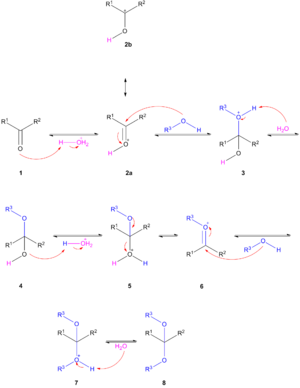| Revision as of 15:26, 21 August 2011 editAtomician (talk | contribs)Rollbackers3,372 edits →Acetalisation of carbonyl groups by alcohols← Previous edit | Revision as of 15:27, 21 August 2011 edit undoAtomician (talk | contribs)Rollbackers3,372 edits fixesNext edit → | ||
| Line 1: | Line 1: | ||
| {{mergeto|acetal|date=February 2011}} | {{mergeto|acetal|date=February 2011}} | ||
| ⚫ | '''Acetalisation''' is an ] that involves the formation of an ] or ]. One way of acetal formation is the ] of an ] to a ] or an ]. Acetalisation is often used in ] to create a ] because it is a reversible reaction. |
||
| ] | ] | ||
| ⚫ | '''Acetalisation''' is an ] that involves the formation of an ] or ]. One way of acetal formation is the ] of an ] to a ] or an ]. Acetalisation is often used in ] to create a ] because it is a reversible reaction. | ||
| ==Acetalisation of carbonyl groups by alcohols== | |||
| Acetalisation is ] ] with elimination of water. The reaction can be driven to the acetal when water is removed from the reaction system either by ] or trapping water with ]s or ]. The general reaction mechanism for acetalisation of a carbonyl group is shown to the right. | |||
| The carbonyl group in '''1''' abstracts a proton from ]. The protonated carbonyl group 2 is activated for ] of the alcohol. The structures '''2a''' and '''2b''' are ]s. After ] of '''3''' by water the ] or ] '''4''' is formed. The hydroxyl group in '''4''' is protonated leading to the ] '''6''' which accepts a second alcohol group to '''7''' with a final deprotonation to the acetal '''8'''. The reverse reaction takes place by adding water in the same acidic medium. Acetals are stable towards ] media. In a '''transacetalisation''' or '''crossacetalisation''' a diol reacts with an acetal or two different acetals react with each other. Again this is possible because all the reaction steps are equilibria. | The carbonyl group in '''1''' abstracts a proton from ]. The protonated carbonyl group 2 is activated for ] of the alcohol. The structures '''2a''' and '''2b''' are ]s. After ] of '''3''' by water the ] or ] '''4''' is formed. The hydroxyl group in '''4''' is protonated leading to the ] '''6''' which accepts a second alcohol group to '''7''' with a final deprotonation to the acetal '''8'''. The reverse reaction takes place by adding water in the same acidic medium. Acetals are stable towards ] media. In a '''transacetalisation''' or '''crossacetalisation''' a diol reacts with an acetal or two different acetals react with each other. Again this is possible because all the reaction steps are equilibria. | ||
| Line 10: | Line 10: | ||
| == See also== | == See also== | ||
| * ] | * ] | ||
| == See also == | |||
| * ] | * ] | ||
| ==References== | ==References== | ||
| {{Reflist}} | |||
| <references/> | |||
| ] | ] | ||
Revision as of 15:27, 21 August 2011
| It has been suggested that this article be merged into acetal. (Discuss) Proposed since February 2011. |

Acetalisation is an organic reaction that involves the formation of an acetal or ketal. One way of acetal formation is the nucleophilic addition of an alcohol to a ketone or an aldehyde. Acetalisation is often used in organic synthesis to create a protecting group because it is a reversible reaction.
Acetalisation of carbonyl groups by alcohols
Acetalisation is acid catalysed with elimination of water. The reaction can be driven to the acetal when water is removed from the reaction system either by azeotropic distillation or trapping water with molecular sieves or aluminium oxide. The general reaction mechanism for acetalisation of a carbonyl group is shown to the right.
The carbonyl group in 1 abstracts a proton from hydrochloric acid. The protonated carbonyl group 2 is activated for nucleophilic addition of the alcohol. The structures 2a and 2b are mesomers. After deprotonation of 3 by water the hemiacetal or hemiketal 4 is formed. The hydroxyl group in 4 is protonated leading to the oxonium ion 6 which accepts a second alcohol group to 7 with a final deprotonation to the acetal 8. The reverse reaction takes place by adding water in the same acidic medium. Acetals are stable towards basic media. In a transacetalisation or crossacetalisation a diol reacts with an acetal or two different acetals react with each other. Again this is possible because all the reaction steps are equilibria.